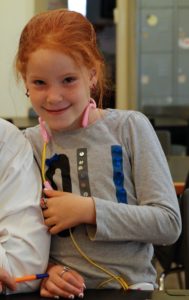Musings from Students of the Pardes Institute of Jewish Studies in Jerusalem
Posted on January 15, 2017 by Hirsch Fishman
Karen Feuer (Year ’99-’00 and current Pardes staff member) shares her thought about Tu B’Shvat.
Seven years ago I underwent induced labor with twins at only 21-weeks into my pregnancy. The pregnancy was no longer safe for me, and this forced, early labor (that sounds nicer than “abortion”) was the result. It was a gut-wrenching experience, but I took great comfort in the fact that I already had two beautiful daughters at home. I also drew immense comfort and hope from the midwife who, after it was all over, blessed me to be back in the hospital within a year, for a much happier birth. The date was erev Tu B’Shevat, 14 Shevat.
I have come to appreciate the significance of Tu B’Shevat in the past seven years. This is partly because of the timing of that early birth and partly because it’s been seven more years of parenting between then and now. Tu B’Shevat has special significance for parents. It is a holiday all about potential, about what you don’t see. About the faith that seeds are sprouting below the ground and sap is rising in the trees preparing for blossom. It is easy to see how these images relate to child-rearing. You “water” and “till” your children, or “seedlings,” and yet the final product is really not up to you. You don’t know how exactly that fruit will turn out, and so many factors are outside of your control. But all the while you trust that your efforts are causing growth. Sometimes this growth is visible to the naked eye, but most of time it remains hidden away until a much later season. I now better understand the challenge of training the eye to see the smallest buds in my children, and indeed, in the world at large.
The other aspect of Tu B’Shevat, which I have come to more deeply appreciate, is the power of our words to give hope and therefore bear fruit.
There are many manifestations of the Tu B’Shevat seder, yet they all have something in common: the centrality of brachot on the various fruits. When you make a blessing before the very physical act of eating, you elevate reality. You could even say you shape reality by insisting on much more than the physical sustenance in front of you. You are acknowledging a greater spiritual reality exists.
Seven years ago, with that midwife’s blessing, I felt hope inside me rise. For the sake of my Tu B’Shevat metaphors, you could call this the sap that rises in the tree well before the blossoms are visible. It was a fleeting feeling. After all, I was encompassed by sadness and emptiness, physically and emotionally. But I remember that moment, that tiny moment of hope that maybe, just maybe, I could be back in that hospital one day soon with a much happier ending.
 Exactly one year less a day later, 13 Shevat, I held a healthy baby girl in my arms. We named her Tamar. The Tamar fruit is significant in that it is one of the sweetest fruits and yet the tree itself flourishes from bitter (or salty) waters. In Hebrew Tamar means “the end of bitterness.”
Exactly one year less a day later, 13 Shevat, I held a healthy baby girl in my arms. We named her Tamar. The Tamar fruit is significant in that it is one of the sweetest fruits and yet the tree itself flourishes from bitter (or salty) waters. In Hebrew Tamar means “the end of bitterness.”
My Tamar continues to bring a lot of sweetness into the world and reminds me of the power of Tu B’Shevat’s subtle message about hope. Hope can sprout even in the dead of winter. You just might not see its fruits for a while.